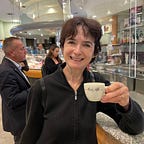Will The Truth Set Us Free In These Polarized Times?
Deep in the heart of Becky Chambers’ award-winning “Wayfarers” sci-fi novel trilogy there’s mention of a show that changed the course of relations between regular humans and some sentient beings on another planet. At first, any meaningful friendship between the two types of “creatures” was impossible. They kept their distance. But then they started to reach the middle ground after some entertaining content emerged in which an alien and a human became friends. It grew wildly popular, and after 10 years, the two civilizations warmed to each other, turning the course of history.
Although not an exact parallel, it kind of reminds me of Norman Lear’s landmark “All in the Family” sitcom, in which a bigoted Archie Bunker made us all laugh as he traded quips and barbs with his much more liberal daughter and son-in-law. Only with Chambers it’s on an intergalactic level.
Wouldn’t it be cool if there was some entertaining content that could help people walk toward the center and find more common ground?
Questions in Our Polarized Times
Here are some burning questions that sparked that little fantasy: how do we, as a society, make sure that members of the general public become better aware of the biases of certain news or social media content (which may be completely hidden or misconstrued)? And how can the public better discern when content contains absolute poppycock falsehoods? Can more be done within schools to educate students? What if there were resources that would help adults as well?
Vanessa Otero provides some answers to all that. She’s the founder and CEO of Ad Fontes Media, which has created a “Media Bias Chart” that determines the political leanings and veracity of many news organizations as well as shows that comment on current events. To do that, it relies on a team of human analysts with political views from across the spectrum. Ad Fontes’ services are used by not only educators and news organizations, but also advertisers that don’t want to be associated with polarizing content or misinformation.
Ad Fontes isn’t the only company that provides this kind of service. There’s All Sides, for example, as well. And there are also some browser extensions that can help spot fake news, as this article in PCMag explains.
The Truth Detectors
According to Otero, “there are people that are tired of the biased, really dramatic news. And there is more of a demand for news that’s centrist or balanced or factual.” She points to the emergence of fact-reporting newsletters like 1440 as well as the emergence of the NewsNation channel, which is competing with services like CNN to be more objective.
All that sounds great. But the current situation is complicated, according to Kelly McBride. She’s an SVP at The Poynter Institute and NPR’s public editor. “Some newsrooms are becoming decidedly more blatant in their bias, but others are decidedly less so,” she told me in an email exchange.
“Some newsrooms have identified the root cause of their biases (often rooted in the geography, educational history, and race of their staff) and are working to address some of those causes. And sometimes, when newsrooms address a bias, news consumers who share that bias perceive the action as a tilt toward bias, rather than away from it,” McBride added.
Yeah, the term “Catch 22” springs to mind.
I asked McBride if she thinks we have enough tools, like Ad Fontes’ Bias Chart, to decipher the veracity and subjectivity of specific news content. And the answer was “no.” The problem is “we don’t have an agreed-upon definition of bias,” McBride wrote. “For instance, is story selection itself evidence of bias? Does language choice reveal bias? Are we looking specifically for political bias? Or are we more broadly looking for cultural bias? What about educational bias? Good tools cannot be built unless we figure out what we are trying to detect.”
If this makes you want to throw up your hands in frustration, I’m with you. That’s one big can of worms. But what Ad Fontes is doing gives me hope. Otero describes it as akin to a “nutrition label.” So conceivably, somebody might look at Ad Fontes’ analysis of a particular news show and conclude that it’s junk masquerading as news.
In the meantime, if there are any 2023 versions of “All in the Family” out there that could bring us more together — please let me know. We could use more reasons to laugh — and see each other’s humanity.
